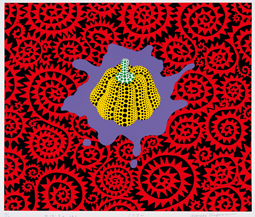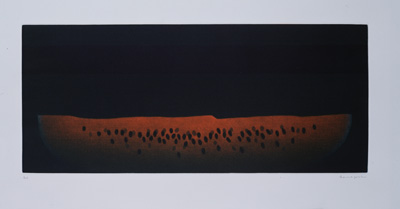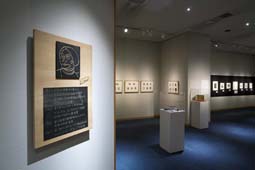 |
|
Here and There introduces art, artists, galleries and museums around Japan that non-Japanese readers and first-time visitors may find of particular interest. The writer claims no art expertise, just a subjective viewpoint acquired over many years' residence in Japan.
|
|
 |
|
|
 |
 |
Kusama, Hamaguchi, Hagiwara: Printmakers on Parade at the Kichijoji Art Museum
Alan Gleason |
 |
 |
|
 |
Yayoi Kusama, "Heart (1)" (1999), screenprint,
47.7 x 59.6 cm, © Yayoi Kusama |
|
Yayoi Kusama, "Pumpkin (A)" (1990), screenprint,
45.0 x 53.5 cm, © Yayoi Kusama |
Back in pre-bubble Tokyo, before there was an art museum on every block, the only places where you could see an exhibition of famous Western artists were often the in-house galleries of major department stores. "Museum" was a generous appellation for these cramped spaces, usually a couple of rooms tucked behind the stationery corner on the top floor of the store. As a teenager in Tokyo I remember getting my first exposure to Picasso and Renoir in crowded little galleries atop the Parco or Seibu stores in Shibuya and Ikebukuro.
How times have changed. Now every suburb has its own art museum, not to mention the big ones downtown. Though budgets are not what they used to be, these municipal museums do an admirable job of juggling schedules that necessarily alternate between hometown heroes, local amateur shows, and the occasional big-budget, crowd-drawing retrospective of a world-class artist. (Often, of course, there is a local connection to these big names as well.)
Hidden away on the top floor of the Coppice department store in Musashino, a western Tokyo suburb, the Kichijoji Art Museum fits this profile so perfectly that it is all too easy to miss. Its footprint is modest -- two small galleries with permanent exhibits and a larger one for special shows. At street level, a tiny sign points the way to the appropriate elevator, barely registering amid the cacophony of the bustling Sun Road shopping mall next to Kichijoji station.
Open since 2002, the museum is a relative newcomer to the roster of locally-funded museums in greater Tokyo. But, as I found out on a recent visit, it appears to have a curatorial staff with excellent instincts and the savvy to make optimum use of the limited space at their disposal.
 |
Yayoi Kusama, "Dress" (1982), lithograph,
58.6 x 47.8 cm, © Yayoi Kusama |
A case in point is the current (until November 7) exhibition of small works, mostly silkscreen prints, by the celebrated Yayoi Kusama. Known for her attachment to certain obsessively iterated motifs -- most notoriously, phalluses and polka dots -- Kusama will probably forever be thought of as the other "crazy female Japanese avant-garde artist" who, along with Yoko Ono, made a splash in New York in the sixties. An elaborately staged retrospective at the downtown Mori Art Museum a few years back exploited this image to the hilt, filling the galleries with exploding plastic inevitables -- primary colors and polka dots everywhere. Overwhelming, and oh so pop.
The Kichijoji show is the diametric opposite, refreshingly and edifyingly so. Now over eighty, Kusama is no less concerned with organic cellular forms (the apotheosis of which may be her Heart series), yet the work here is low-key and intimate enough to invite thoughtful contemplation. Her silkscreens, which predominate in this exhibition, are eloquent testimonials to her mastery of color and composition, her devotion to detail, and her consummate skill as a printmaker.
Thanks to a tie-up with the Matsumoto City Museum of Art in Kusama's hometown, the Kichijoji Art Museum has access to a rich selection of her work past and present. Highlights of this show include Kusama's ongoing Infinity Nets series of hypnotic mesh patterns and her Pumpkin prints of exquisitely lumpy, spotty vegetables.
Perfectly complementing Kusama are concurrent exhibitions of two printmakers whose works are a permanent feature at the Kichijoji Museum: Yozo Hamaguchi (1909-2000) and Hideo Hagiwara (1913-2007). Each has a gallery devoted to his works, which the museum rotates every three months or so according to various, often season-related, themes. Hamaguchi and Hagiwara are two reasons why a visit to the Kichijoji is well worth it even after the Kusama show ends.
 |
|
 |
Yozo Hamaguchi, "Watermelon" (1981), color mezzotint,
23.3 x 54.1 cm, © Musée Hamaguchi Yozo: Yamasa Collection |
|
Yozo Hamaguchi, "Twenty-Two Cherries" (1988), color mezzotint, 54.6 x 23.8 cm,
© Musée Hamaguchi Yozo: Yamasa Collection |
The museum's focus on these two artists is not coincidental. Despite the fact that neither man lived in the immediate area, these collections are to a large degree the museum's raison-d'etre. In the mid-1990s, the city of Musashino received a donation of 100 of Hamaguchi's works from the artist through the good offices of a local protege, and shortly thereafter an even larger gift of prints from Hagiwara after an exhibition by the artist at a local cultural center. It was to accommodate these invaluable acquisitions that the city decided to open a museum in a municipally-owned space atop a Kichijoji department store. It now owns 550 works by Hagiwara and 150 by Hamaguchi, two of the largest collections by these artists found anywhere.
 |
Hideo Hagiwara, "Face No. 5" (1991), woodprint,
67.6 x 56.7 cm |
Both Hamaguchi and Hagiwara are celebrated in their own right, and it is fortuitous that one can see their work together with Kusama's right now. Superficially it would seem that the three have little in common, but the museum has seen fit to highlight their points of intersection. Hamaguchi is revered as one of the world's greatest masters of the difficult mezzotint process; his work is dark, subdued, dominated by the subtlest gradations of color and abstract arrangements of simple still-life objects. But his attention to detail and his love of circles, curves and globular fruit -- cherries, grapes and watermelons in particular -- produce striking similarities to Kusama's work.
By contrast, Hagiwara's woodblock compositions are wild, colorful, sprawling affairs, but his avant-garde tendencies never detract from an inherent lyricism. Concurrent with the Kusama exhibition, the Kichijoji curators have wisely chosen to showcase his many astronomically-themed works. Chock-full of globes and clusters of light, these series -- Nebula, Stars on the Sand, Starlight Night -- occupy a spot somewhere between Hamaguchi and Kusama on the scales of brightness and drama. Viewed in tandem, the three shows provide an inspiring lesson in the art of printmaking and the myriad applications of the dot, the circle, the sphere.
 |
|
 |
| Hideo Hagiwara, "Nebula No. 6" (1990), woodprint, 43.7 x 63.5 cm |
|
Interior view, Hideo Hagiwara Room
at the Kichijoji Art Museum, © Kichijoji Art Museum
|
|
|
|
|
|
|
 |
|
 |
Kichijoji Art Museum |
|
7th Floor, FF Building, 1-8-16 Kichijoji Honcho, Musashino City, Tokyo
Phone: 0422-22-0385
Hours: 10:00 - 19:30 (closed on the last Wednesday of each month and during the New Year holiday)
Transportation: Three-minute walk from the central (north) exit of Kichijoji station (JR Chuo and Keio Inokashira lines) |
 |
|
 |
|
|
 |
 |
Alan Gleason
Alan Gleason is a translator, editor and writer based in Tokyo, where he has lived for 25 years. In addition to writing about the Japanese art scene he has edited and translated works on Japanese theater (from kabuki to the avant-garde) and music (both traditional and contemporary). |
|
|
|
 |
|